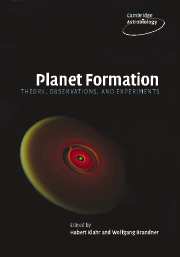Book contents
- Frontmatter
- Contents
- Preface
- Acknowledgments
- 1 Historical notes on planet formation
- 2 The Formation and Evolution of Planetary Systems: placing our Solar System in context
- 3 Destruction of protoplanetary disks by photoevaporation
- 4 Turbulence in protoplanetary accretion disks: driving mechanisms and role in planet formation
- 5 The origin of solids in the early Solar System
- 6 Experiments on planetesimal formation
- 7 Dust coagulation in protoplanetary disks
- 8 The accretion of giant planet cores
- 9 Planetary transits: a first direct vision of extrasolar planets
- 10 The core accretion–gas capture model for gas-giant planet formation
- 11 Properties of exoplanets: a Doppler study of 1330 stars
- 12 Giant-planet formation: theories meet observations
- 13 From hot Jupiters to hot Neptunes … and below
- 14 Disk–planet interaction and migration
- 15 The brown dwarf–planet relation
- 16 Exoplanet detection techniques – from astronomy to astrobiology
- 17 Overview and prospective in theory and observation of planet formation
- References
- Index
12 - Giant-planet formation: theories meet observations
Published online by Cambridge University Press: 14 September 2009
- Frontmatter
- Contents
- Preface
- Acknowledgments
- 1 Historical notes on planet formation
- 2 The Formation and Evolution of Planetary Systems: placing our Solar System in context
- 3 Destruction of protoplanetary disks by photoevaporation
- 4 Turbulence in protoplanetary accretion disks: driving mechanisms and role in planet formation
- 5 The origin of solids in the early Solar System
- 6 Experiments on planetesimal formation
- 7 Dust coagulation in protoplanetary disks
- 8 The accretion of giant planet cores
- 9 Planetary transits: a first direct vision of extrasolar planets
- 10 The core accretion–gas capture model for gas-giant planet formation
- 11 Properties of exoplanets: a Doppler study of 1330 stars
- 12 Giant-planet formation: theories meet observations
- 13 From hot Jupiters to hot Neptunes … and below
- 14 Disk–planet interaction and migration
- 15 The brown dwarf–planet relation
- 16 Exoplanet detection techniques – from astronomy to astrobiology
- 17 Overview and prospective in theory and observation of planet formation
- References
- Index
Summary
Introduction
The two mechanisms that have been advanced for explaining the formation of giant planets are core accretion (“bottom up”) and disk instability (“top down”). Core accretion, the conventional mechanism, relies on the collisional accumulation of planetesimals to assemble ∼ 10 M⊕ solid cores, which then accrete massive gaseous envelopes from the disk gas (Mizuno, 1980; Lissauer, 1987; Pollack et al., 1996; Kornet et al., 2002; Inaba et al., 2003). In this scenario, the ice-giant planets probably did not form in situ (Levison and Stewart, 2001), but rather formed between Jupiter and Saturn and then were scattered outward to their present orbits (Thommes et al., 1999, 2002).
The alternative to core accretion is disk instability, where gas-giant protoplanets form rapidly through a gravitational instability of the gaseous portion of the disk (Cameron, 1978; Boss, 1997, 1998b, 2000, 2002a,b, 2003, 2004; Gammie, 2001; Mayer et al., 2002, 2004; Nelson, 2000; Nelson et al., 1998, 2000; Pickett et al., 1998, 2000a,b, 2003; Rice and Armitage, 2003, Rice et al., 2003a) and then more slowly contract to planetary densities. Solid cores form simultaneously with protoplanet formation by the coagulation and sedimentation of dust grains in the clumps of disk gas and dust.
- Type
- Chapter
- Information
- Planet FormationTheory, Observations, and Experiments, pp. 192 - 202Publisher: Cambridge University PressPrint publication year: 2006
- 2
- Cited by



